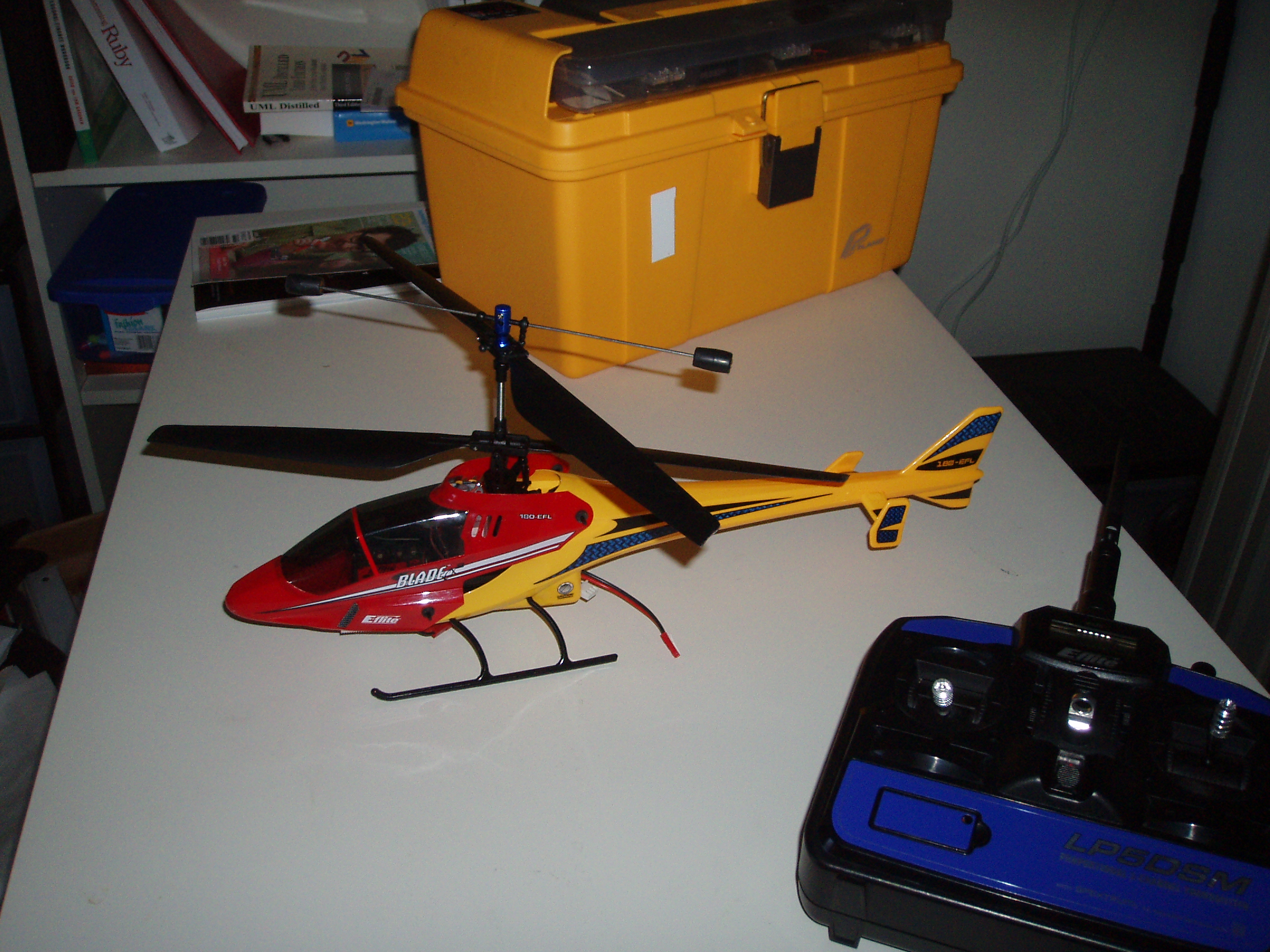I’ve been remiss in my duty as blogger extroardinaire. A new hobby, and I haven’t yet informed the world!
For the past couple months, I’ve been fascinated by R/C helicopters. As far as I can tell, this all started when I was at Fry’s drooling over the Lego Mindstorms in the toy aisle. The abundance of toy helicopters caught my eye. I didn’t buy one right then, but the thought was planted in my mind.
I have been exposed to a lot of aerospace-related enthusiasm over the years. My dad works in aerospace, Jen has been squeeing about anything that flies for as long as I’ve known her, and then there was that whole Space Grant thing I did in college… Anyway, despite all of that I never really took the time to fly anything myself.
Within a few days, I walked out with a $25 infrared microhelicopter: a cheap clone of the Silverlit Picoo Z. This is a really fun little toy, and it was an instant hit at work. After I flew mine around the office a bit, at least three coworkers ended up buying one. It’s a lot of fun for the price, but it’s frustrating if you’re expecting to have a reasonable amount of flight control. There are only two low-resolution channels, and it’s pretty unstable.
Following in footsteps of one of my coworkers, I graduated from the Microgear helicopter to an E-flite Blade CX2. This is a really great helicopter for the price. Stable, maneuverable, upgradable, and ready-to-fly with a good supply of spare parts for about $250. This was Paul’s birthday present to me 🙂
I’ve been having a lot of fun with this. It’s very easy to fly indoors, and with a little practice it’s flyable in low winds. I usually fly it in the
apartment’s courtyard, though it’s insanely fun to fly around the new buildings at work.
Things that interest me about model helicopters:
- Aerobatics. I’m working on flying smoother and faster figure-eights on the BCX2, and I often run into the limits of the heli’s design when turning sharp corners. I’m curious what it’s like to fly a more capable heli like the Blade CP Pro or the Align T-Rex.
- Airborne nerf gun!
- A homebrew light kit for flying at night, perhaps with navigation lights plus a variable-power spotlight.
- Aerial photography. This interests me a lot, actually. The OpenSourceQuadroCopter or a similar quad-rotor design seems to be a better bet for stability, but I’ve been experimenting to see what’s possible with the Blade CX2.
- First Person View (FPV) flight. I’ve done some experiments with mounting a small wireless security camera on my Blade CX2, but some folks out there really know how to do this right. Some of those videos are very impressive.
- Tune-ups. Crashes suck, but the mechanic in me loves tinkering with small electro-mechanical parts.
Besides the little security camera, I’ve been experimenting with taking video from the Blade CX2 using a Flip Video camera. These are little solid-state camcorders that can hold an hour of TV-quality video. I stripped down a Flip Video camera to just a bare PCB and lens (without LCD) to reduce weight and power consumption. The board is conformal-coated in Acrylic to add a little bit of protection from the elements, especially electrostatic discharge. The whole camera is about 25 grams, and it can be powered via an extra +5V input on the proprietary connector. I run it from one of the extra servo connectors on the BCX2’s 4-in-1 control unit. (If you try this yourself, it’s important to use the same +5V input. The battery power input is designed for 3V only, and the +5V input on the USB port will put the camera into downloading mode.)
The only problem this leaves is how to mount the camera to the helicopter. My BCX2’s lower rotor is quite steady, but the upper rotor is a bit wobbly. The vibration is significantly less if you’ve just replaced both the inner and outer shafts, but even after a lot of mechanical tweaking I couldn’t get my heli running smoothly enough that a camera velcro’ed to the body would give me a clear picture. I ran experiments with a few different mounting systems. The one that seemed to perform the best was based on a rubber-band suspension (to isolate the camera from high-frequency vibration) plus a bit of foam to damp out oscillations in the rubber bands. I also coiled the camera’s power cord, to minimize the amount of vibration it would transmit. The prototype looks kind of silly, but it’s a significant improvement over mounting the camera directly.
The heli’s CG is quite good in this configuration. The servos and the battery holder are reversed, so the camera on the “front” of the heli is actually where the tail would normally mount. Its weight is counterbalanced by the 4-in-1 control unit on the opposite side. The heli has less rotational inertia than it would normally, but I compensate for that by decreasing the gyro gain. It doesn’t fly as well as a stock BCX2 flies, but a stable hover is still possible. Flight times are also quite good. I can get about 8 minutes of video+flight on a charge. It weighs nearly the same as the stock BCX2 body pieces, so most of the overhead is probably electrical. Without the LCD, the camera draws around 350 mA while recording.
None of the videos I’ve recorded so far are terribly impressive. This is the unedited footage from one test run. Individual frames from the image are quite clear, but the residual low-frequency vibration is causing some really strange wobbling in the picture. I saw this behaviour for the first time when I tested the camera outdoors.

